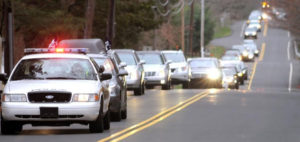Funeral Processions and Car Crashes

Who has the right of way?
We’ve all been caught by them – a funeral procession. Everyone puts up with the inconvenience out of respect. However, a funeral procession can also create the potential for serious car crashes. This article will discuss the legal issues involving funeral processions.
A funeral procession is defined as a convoy of cars made of the relatives and friends of the deceased. These convoys typically move from the funeral home on their way to the burial site or cemetery, sometimes inconveniencing other road users due to their sheer size.
Right of Way for Funeral Processions
Generally speaking, a funeral procession has the right of way and others must yield to funeral processions. Right of way can be defined as who, according to the law, should be allowed to pass first on our roads, and which road user should yield. Any vehicle in a funeral procession has the right of way as long as it has lighted headlights, displays a sign or placard and is headed by a vehicle which displays alternating flashing lights, or is led by an emergency vehicle. This is why we yield for funeral processions-the traffic laws grant them the right of way.
What’s more, it is also a traffic offense (as well as disrespectful) to break into or cut through a funeral procession. The law treats a funeral procession as one long vehicle. The law is quite clear: funeral processions and the vehicles within in them hold a preferential place under our traffic laws.
We have many potential clients contact us after being in an accident with a funeral procession. Our first question is, “were you in the funeral procession?” If they answer “no,” we typically decline the case and explain the right of way rules from above. Even if they have the green light, a funeral procession has the right of way. Of course, if they are in a car crash and they were part of the funeral procession, we make an appointment and represent them.
Despite the right of way laws which favor funeral processions, there are motorists in a funeral procession who abuse this privilege and disregard the safety of other road users. Just because funeral processions have right of way doesn’t mean they can abuse it and act in a negligent manner.
Funeral Procession Exceptions
While funeral processions are giving preferential treatment under the law, they are not totally immune under the traffic laws. The law requires that a funeral procession travel as compactly and closely as possible. This means that drivers in a funeral procession should not leave big gaps between them and the car in front of them. Likewise, cars cannot speed to catch up if they fall behind. They also must exercise care when crossing an intersection on a red light.
Duty of Funeral Homes for Funeral Processions
The law does place an obligation on a funeral home to organize and implement a funeral procession is a safe manner. Typically, the funeral home will be the lead car in a funeral procession, and as such, must travel at a speed so that the remaining cars stay compact. If the lead car in the funeral procession goes too fast, it will be hard for the remaining cars to proceed safely. You will often see additional cars provided by the funeral home which stop at intersections to alert traffic to stop, despite their green light. There have been cases where the funeral home has been sued for negligently managing a funeral procession. If you see a funeral procession in disarray, it is likely the fault of the funeral home.
We should yield to funeral processions out of respect and because the law requires it. But, a car crash resulting from the negligence of a funeral procession or driver can be grounds for a lawsuit. Please contact McCready, Garcia & Leet today at 773-779-9885 for your free consultation into injuries as a result of funeral processions. Thanks, and we look forward to hearing from you.

